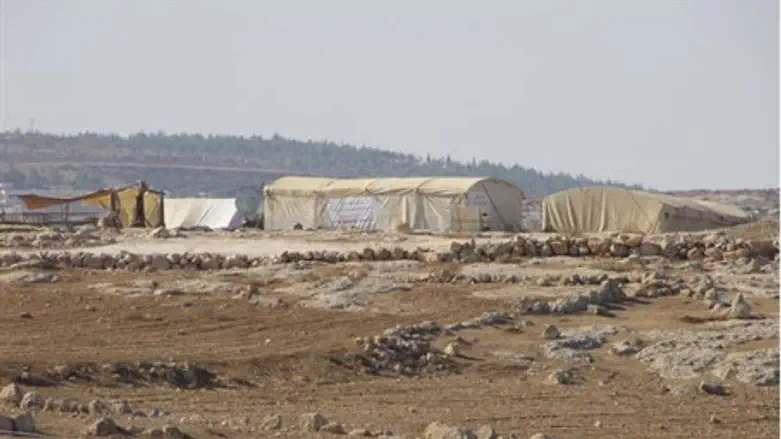
Nadav Abramov, manager of the declared national heritage site at the ancient Jewish village Susya in southern Hevron, debunked the claims that the impending demolition of the illegal Arab settlement Khirbet Susiya will somehow erase an "ancient Arab village."
Speaking to Arutz Sheva, Abramov explained, "there is no village here. This is a hamula, a family (of Arabs) that arrived 20 years ago from (the nearby town of) Yatta; they settled on agricultural land upon which building is forbidden, including the archaeological site of Susya, they built tents and tin shacks all while illegally squatting."
Khirbet Susya, illegally constructed on the ruins of an ancient Talmudic-era Jewish village of the same name, has been targeted by a demolition order from the Supreme Court. Tellingly "Khirbet" means ruins in Arabic, clearly unveiling the attempt to "Arabicize" the ancient Jewish site.
"The Supreme Court put out destruction orders on them, this is a hamula of 200 people who built tents and today they call it a village. Since the Supreme Court discussion they created a false narrative that unfortunately is getting backing even at the White House, as if they're evacuating an Arab village here and they are being expelled from us."
"According to all findings Susya was a ruin, an (Arab) village like this never existed," emphasized Abramov.
He pointed out that the Arab settlers entered Susya on Area C of Judea designated as being under full Israeli control under the Oslo Accords from Yatta, located in Area A designated as being under Palestinian Authority (PA) control.
"This is an attempt to take control of Area C which is under full Israeli control," said Abramov. "They have a plan to seize more lands in southern Har Hevron and for this struggle they are receiving lots of money from Europe."
As he noted, just this week it was revealed that EU funds are fueling the campaign to defend the illegal Arab settlement, as Europe and the US warn Israel not to enforce the law against the settlement.
The real Susya
Radical leftists groups backed by Europe and strengthened by statements from the Obama administration have been working to thwart the demolition of the illegal Arab village.
Arab residents of the settlement petitioned the Supreme Court to postpone the demolition, in a request that was rejected giving the state the green light to conduct the demolition. Previous Arab petitions had been heard at the court and overruled as lacking substance.
But the Arab residents appear unwilling to forego their illegal squatting on the ancient site; Jihad al-Nawajaa, head of the council of the settlement, told AFP, "even if they push us out by force, we will come back the next day."
However, historical evidence blows a hole in the claims of Susya being an Arab village.
Abramov reminded that the ancient Jewish village of Susya was declared as a national heritage site, noting that back in the Talmudic-era "Jews lived here from 350 CE until 800 CE deep in the Byzantine Period, there were synagogues and mikvaot (ritual baths) and more."
"The reason they abandoned isn't known to us, but excavations in the late 1960s revealed the magnificent history of the Jews here."
Historical documents have thoroughly debunked claims of an Arab link to Susya, showing how the Arab "village" is a very recent phenomenon, in contrast to the indigenous Jewish connection to the site.
Tzviki Bar-Hai, then head of the Har Hevron regional council, explained to Arutz Sheva in late 2013 how the Palestinian Arabs first settled in Susya.
"I was there in 1976, and aside from the synagogue that was built here in 1969, there wasn’t a living soul," he recalled. “We were able to restart the archaeological digs in 1983, and then, too, there were no Palestinians around.”
He noted how Arab farmers began to visit Susya for one or two nights at a time during certain parts of the year starting in 1986, revealing that those now claiming to be residents of Susya are actually from the nearby Arab town of Yatta.
"In recent years a few Arab families from Yatta are trying to settle nearancient Susya and to argue that they were expelled from the village of Susiya – which never existed," he said. "They are all from Yatta. They are supported by leftist activists, who come on weekends to help create the narrative of expulsion."